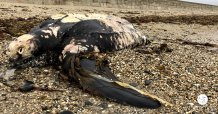Articles

The turtle weighed more than 200kg
Plastic found in stomach of dead turtle on Cornish beach
Plastic has been discovered in the stomach of a leatherback turtle found dead on a Cornish beach on Sunday (12 August).
The plastic did not kill the 1.8-metre turtle, but scientists say it is further evidence of widespread pollution – with plastic now found in “almost all” turtles examined.
The team that carried out the autopsy, from the University of Exeter’s Penryn Campus, believe the turtle might have been killed by a boat propeller.
The animal washed up at Marazion near Penzance after summer storms, and the Exeter researchers ask people using boats to be careful as more leatherbacks are likely to be in the waters off Cornwall.
“The turtle had been at sea for some time and was severely decomposed,” said Professor Brendan Godley, leader of the university’s marine strategy and a former veterinarian, who co-ordinated the investigation.
“Prior to her death she was in good condition and had eaten relatively soon before dying.
“She showed no obvious entanglement injuries but had deep cuts across her shell that are consistent with propeller wounds.
“It is not 100% sure that these wounds happened prior to death, but such injuries do point to a possible cause.”
Professor Godley carried out the autopsy with the help of three University of Exeter PhD students: Emily Duncan, Liliana Poggio Colman and Dominic Tilley.
It was not possible to establish exactly when the turtle died, but Professor Godley felt the level of decomposition meant it died in UK waters or nearby.
Duncan, who sailed across the Pacific earlier this year to study the presence and impact of micro-plastics in the region, said: “Leatherback turtles are known to swallow plastic bags which they are thought to confuse with their natural jellyfish prey.
“We can confirm that this is not what killed this animal. She had partially digested food inside, as well as a piece of clear plastic. It is unfortunate that almost all turtles examined now around the world have plastic in their gut.”
Poggio-Colman, who is studying the population of leatherbacks in her native Brazil with funding from the Brazilian government, said: “Based on satellite tracking studies around the Atlantic, it is likely that this female did not come from Brazil or the largest Atlantic population in Gabon, but from the wider Caribbean area from a site like French Guiana, Trinidad or Colombia.
“It is amazing to think that she would travel all this way.”
Professor Godley added: “It has been a warm summer and, as Lewis Pugh has been finding out in his Channel Swim, there are many jellyfish around.
“This means that there are likely to be more leatherbacks and sunfish which will stay in the area.
“It would be prudent for boaters, especially in faster vessels, to pay especially close attention for animals basking at the surface until the waters cool down in November.”
Date: 13 August 2018
